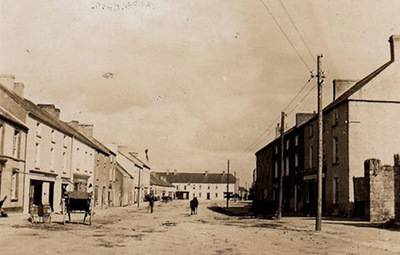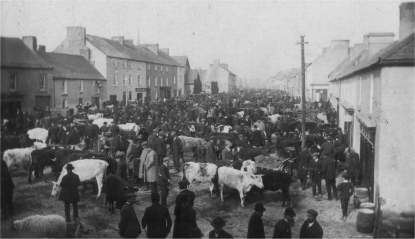Heritage & History
Cloughjordan has an extraordinary amount of all kinds of heritage. Ancient sites, old buildings, the birthplace of an Irish patriot, the railway and extensive natural heritage all combine to make Cloughjordan the ideal place for heritage enthusiasts.
Early Times
The town of Cloughjordan is in the North West corner of County Tipperary roughly half way between Roscrea and Nenagh. People have lived in the area for millenia: a prehistoric burial cairn was discovered in nearby Ardcroney which dates back around five thousand years and a gold collar was also discovered in the area which may date back three thousand years.
The surrounding area is full of signs of later habitation including a major ring fort at Rathurles, megalithic burial sites and fulacht fia. A large hoard of bog butter was discovered near Cloughjordan which dates back to Viking times and castles in the area can be dated to the coming of the Normans.
Modreeney was the original place of settlement in the area prior to the Cromwellian plantation in the mid-seventeenth century, which saw the establishment of the town of Cloughjordan as the main centre of population.
Cloughjordan House
One school of thought holds that the town was named after Jordan de Marisco, who is reputed to have built a tower house at Cloughjordan and inserted a stone which he brought from the Holy Land in its walls. A native of Somerset but of Norman origin, his exploits in the Holy Land earned him the name Jordan. He was the son of Geoffrey de Marisco, who may have built Nenagh castle. After the Norman invasion in the late twelfth century, the de Mariscos became a powerful family in the area of Lower Ormond, with castles at Latteragh, Ballycapple and Ballinaclough also. The name survives today in the area as Morris or Morrissey.
St. Kieran’s Church of Ireland
It was through marriage to a Harrison that the Prittie family and later Lord Dunally became very powerful figures in the life of the town of Cloughjordan. From the early eighteenth century onwards, as owners of the land on which the town was built, successive Lords Dunally controlled the economy of the town and to a large extent the lives of its inhabitants. This situation lasted until well after the middle of the twentieth century, when the last tenants bought out the ground rents for the land on which their properties were built.
Catholic Church of SS Michael and John
The town of Cloughjordan consists of one main street, with three branching side streets. Halfway down Main Street, is the Church Meadow or Town Green, bordered by a stone wall and mature lime trees; setting the stage for the elegant St. Kieran’s Church of Ireland church, built to the design of James Pain in 1828. To the left of the church are the Militia Houses, reputed to have been built as a nineteenth century army barracks, but never used as such. To the right is the modern St. Kieran’s hall, standing on the site of the first purpose-built school in the town. The beautifully simple Methodist Church, built in 1875 is on Main Street, while on Templemore Road, the impressive Catholic Church of SS Michael and John, built to the design of George Ashlin in 1899, creates a dramatic vista at that entrance to the town. The oldest and most historically significant domestic building in the town, Cloughjordan House, is situated on the Shinrone Road.
Market Town
Before the building of a stone castle in Cloughjordan there had been a settlement in nearby Modreeney. Captain John Harrison, a Cromwellian grantee of land in the area became a central figure in the growth of Cloughjordan as the major settlement, as it was he and his son who built houses there for the soldiers of his regiment. He incorporated the old de Marisco tower house into a new building. Later a descendent of the Harrisons married into the Prittie family, also Cromwellian grantees, and the lands became the Dunalley estate under Lord Dunalley after 1800. Ground rent was paid by many householders in Cloughjordan to the Dunalley estate until the late twentieth century. The town had, as a result, a mix of Protestant and Catholic religions, which remains the case today.
During the nineteenth century market fairs were held in Cloughjordan but it was the arrival of the Great Southern and Western Railway in 1864 that established Cloughjordan as a major market venue.
A branch line had been built from Ballybrophy, on the Dublin to Cork main line, to Roscrea and on to Birr to facilitate the military barracks there and it was decided to link Roscrea with the Nenagh to Limerick branch line. The railway brought many changes, not least the standard railway time, as previously Cloughjordan could be up to one hour adrift from other towns. The possibility of travel was opened up to many more people with a trip to Dublin or Limerick now taking only hours instead of days. The railway also brought goods, which had previously been brought by canal boat to Dromineer on Lough Derg and onwards by horse and cart. But it was in the ability of the railway to take large amounts of livestock quickly to the Dublin and British market that assured Cloughjordan’s market fairs and allowed the surrounding farms to prosper.
Fairs brought many people and increased business to the town. At least once a month the entire town was given over to the marshalling of livestock and the fostering of trade. Traders arrived by train and stayed in the commercial hotels. Farmers bought and sold goods and cattle and celebrated successful deals. Their wives came to buy provisions with the proceeds and to ensure the menfolk got home. Middle-men could get involved, young lads would get a little work and shopkeepers and publicans would do a roaring trade. And, as MacDonagh wrote of Nenagh fair… “There again were thimble men, And shooting galleries, And Card trick men, Of all sorts and degrees”.
Cloughjordan’s success as a market town waned with the coming of motor transport. The centralising of cattle sales in Marts, mostly in big towns like Nenagh, also had the effect of reducing trade. The railway continued to play its part in the transport of cattle into the late twentieth century. The transport by rail of beet to the sugar factory in Thurles grew throughout the twentieth century.

Modern-day Cloughjordan is quieter than in those times described above. Yet business continues and the recent revival of a twice-monthly street market give us a little taste of the old town market fairs. These are held on the first and third Saturday of the month. Nowadays the market offers fresh home-made produce, organic foodstuffs and fresh vegetables, as well as hand-made crafts.
Thomas MacDonagh
Member of the Provisional Government of the Irish Republicand commandant of the 2nd Battalion of the Irish Volunteer in 1916
Thomas MacDonagh is best known as one of the leaders of the Easter Rising of 1916 and signatory of the Proclamation of the Provisional Government, one of the most significant events in Irish history. The people of Cloughjordan are honoured to count him as a native son. They read with pride the many references he has made, through his poetry, to the places and events of his childhood, happily spent in Cloughjordan.
Thomas made many references to the local places of his youth in his poems;
‘I wish I were today on the hill behind the wood-
My eyes on the brown bog there and the Shannon river-
Behind the wood at home,’
Lyrical Poems was published in 1913, described by Thomas as containing “all that I wish to preserve of my previous work”. Reminiscences of Cloughjordan inspired two poems in particular; The Man Upright and The Night Hunt.
In 1913 the Irish Volunteers were formed and Thomas MacDonagh was appointed a member of the Central Committee. He was given command of the Second Dublin Battalion. He co-organised the Volunteers’ march to Howth, in July 1914, to receive the guns landed by Erskine Childers aboard the yacht, ’Asgard ‘.
In the Easter Rising, which began on Monday the 24th of April, 1916, Thomas MacDonagh, with the rank of commandant, was in command of Jacob’s Biscuit Factory in Bishops Street. His unit, which included his brother Jack, was not subject to any full scale attack. When Pearse and Connolly surrendered on April 26th, MacDonagh was then in supreme command of the insurgents still in action. He surrendered, however, on the following day, Sunday April 27th.
Thomas was imprisoned in Kilmainham Gaol, where, under court martial he was sentenced to death. He was executed with Clarke and Pearse on May 3rd 1916, in the yard of Kilmainham Gaol. He was one of the sixteen leaders of the Rising who were executed. His son Donagh was three and-a-half years old and his daughter, Barbara, only a year. His last letters to Muriel are now in the museum of Kilmainham Gaol.
The intimate MacDonagh connection with Cloughjordan has been strongly fostered over the years and Thomas’s grandchildren, great-grandchildren and descendants of his siblings still maintain contact with the village and its people. Thomas’s parents are buried in the old graveyard at Grawn, on the outskirts of Cloughjordan. A commemorative headstone was erected to the memory of Joseph and Mary MacDonagh in 1993 by the local ICA Guild.
The GAA Park in Cloughjordan also commemorates its famous native son by being named in his honour, and the parish GAA Club bears the name Kilruane MacDonaghs. The MacDonagh family have erected a plaque on the wall of the old school building where his parents were teachers and where he and his siblings had their early schooling.
The MacDonagh Heritage and Cultural Centre houses a MacDonagh museum and a genealogical centre with facilities for visitors and meeting areas for special events.



